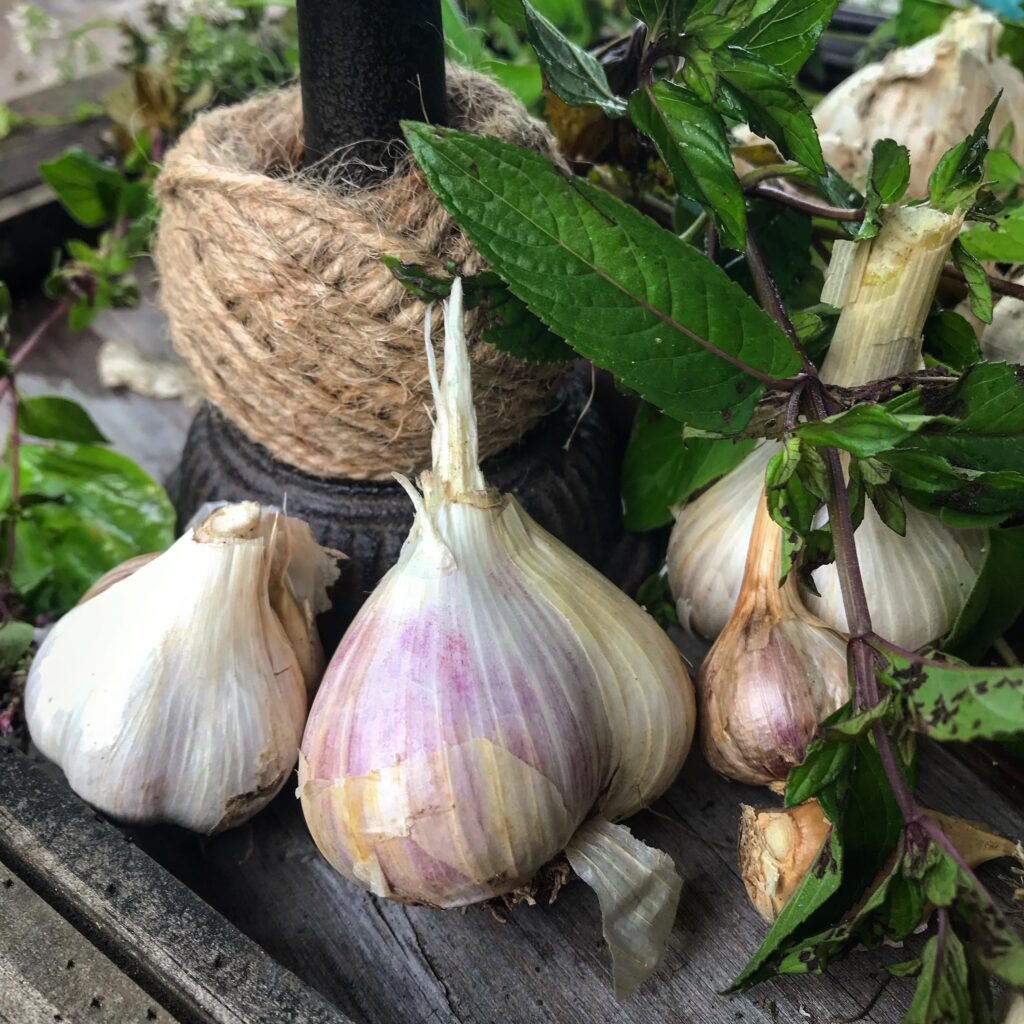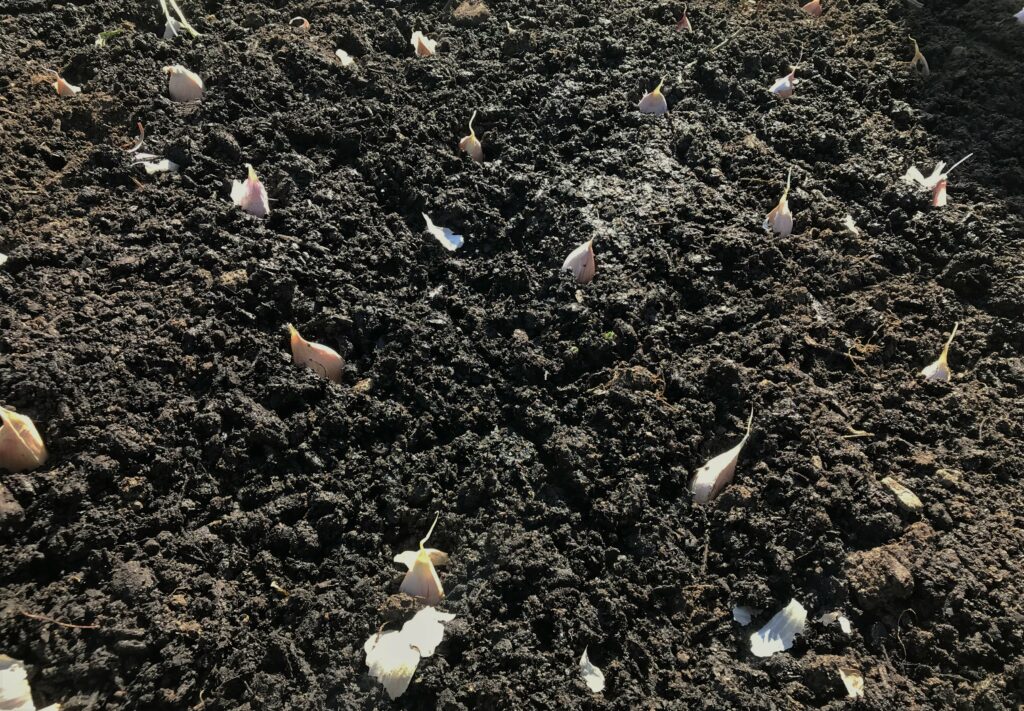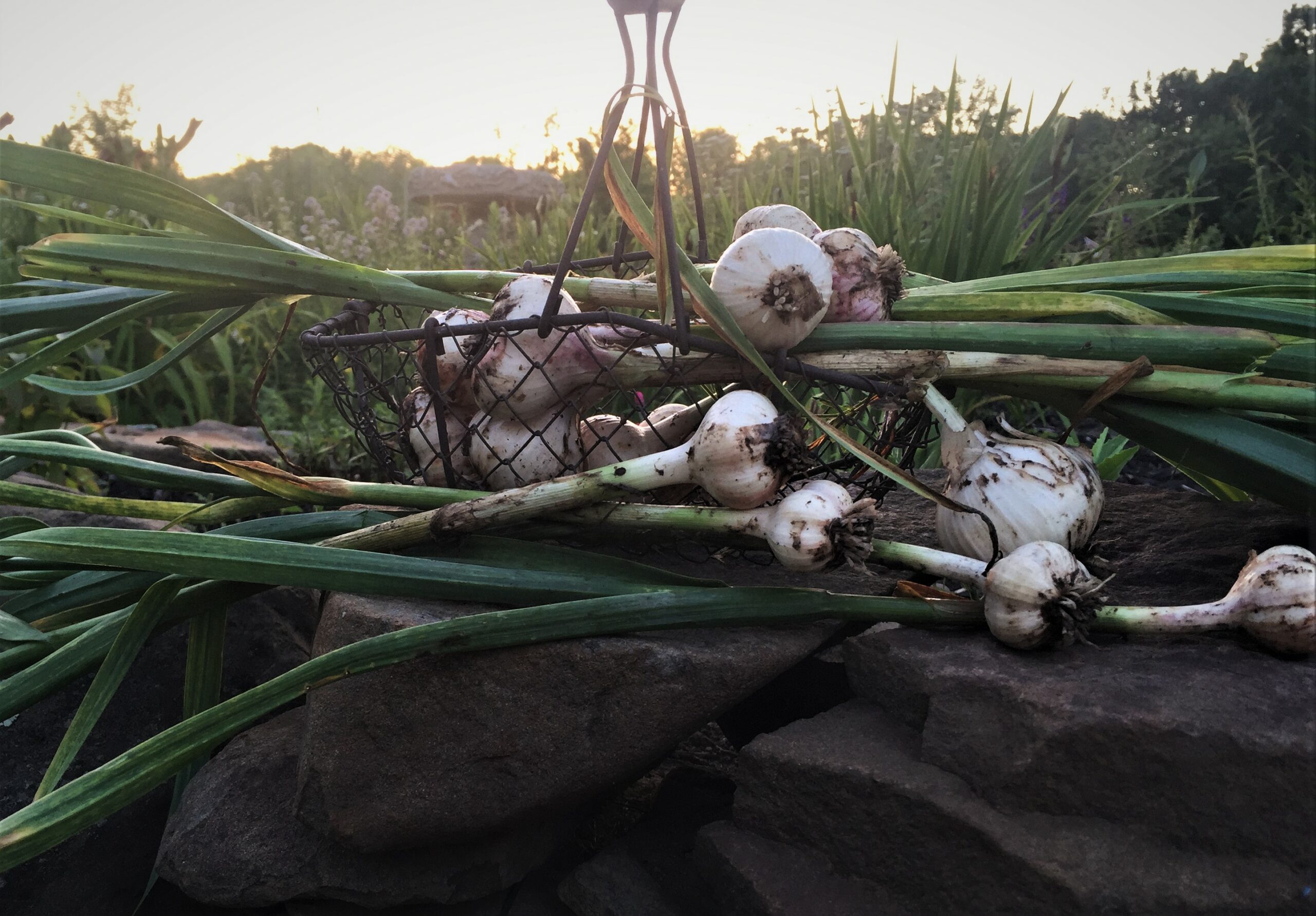It’s fall in upstate NY, the days are getting shorter, mornings are crisp and cool! We’ve had our first frost (and some snow flurries), which subsequently ended our summer garden, and we’re thinking about all the tasks that we need to complete before the real winter weather sets in.
Warm sweaters, thick socks, and wood burning fires also mean it’s time to plant garlic! Keep reading if you’re interested in learning all about planting garlic and which varieties were growing this year.

Garlic is one of the simplest vegetables to plant and harvest, it’s versatile, tastes amazing, and takes up relatively little planting space. It’s a member of the allium family and grows from individual cloves that are broken off from the whole bulb (head). Each clove will grow under the ground and multiple, forming a new bulb and depending on the variety each bulb will consist of 5 – 15 cloves.
Even if you only have a small area dedicated to gardening and growing your own food, I highly recommend growing garlic. I promise you that you’ll have enough room, and more than likely, you’ll have enough space to keep yourself in garlic for months!
What does it take to grow garlic? It’s really about having the correct varieties for your area, planting at the correct time, and the correct soil conditions. After you plant, a little care goes a long way, harvest when the timing is right (the following summer) and prepare it for storage. That’s it… plant, water, wait, a little weeding, harvest, store, and enjoy!

Choosing garlic types:
A google search, scan of seed catalogs, or even a trip to your feed and seed store can you leave you overwhelmed and dizzy with different with garlic options… hardneck, softneck, elephant garlic, not to mention all of the different varieties.
- Softneck Garlic: This type of garlic isn’t as winter hardy as hardneck varieties and tends to do better in warmer gardening zones. Clove size tends to be smaller than hardneck garlic, but it’s great for storage, often keeping for nine to twelve months! Softneck garlic doesn’t develop a scape, so their stems will stay soft and flexible, making them ideal for making braids of garlic.
- Hardneck Garlic: This type of garlic is more winter hardy, and does better in colder gardening zones. Clove size tends be larger than softneck garlic, but don’t store as well. Hardneck garlic develops a long, edible flowering stem, called a scape.
- Elephant Garlic: This type of garlic isn’t actually garlic at all! Elephant garlic is a perennial plant that belongs to the onion family, and is a variant of the common leek, and develops large, garlic like cloves. Like garlic, elephant garlic enjoys a long, cool growing season, and is best planted in the fall.
Where can you buy seed garlic:
Your local feed and seed may carry garlic, greenhouses, nurseys, reputable online companies, local farms, and our favorite – our local garlic festival. If you have a garlic festival nearby, we highly recommend attending, you’ll have the opportunity to try and taste the varieties that you’re interested in growing. Another benefit, the garlic will be from nearby farms and climatized for your growing area. In our experience most farmers are more than happy to talk to you about growing your own garlic and will be able to recommend what bulbs/cloves to buy for planting.
After you’ve successfully planted, grown, and harvested your own garlic crop all you need to do is retain some of the garlic for fall planting!
Planting Garlic:
When to plant your garlic
Garlic goes in the ground for planting in the fall. Where we live (upstate NY, zone 5), we aim to plant our garlic before deep cold sets in, we like to use Halloween as our marker. Our goal is to get the garlic in the ground and planted before Halloween. For both warmer and cooler areas you’ll want to adjust you planting time. The goal is to get the garlic in early enough to start developing root growth, without having the garlic emerging from the ground and putting out tender green top growth.
We’ve had success planting garlic in the beginning of October and also as late as the second week of November. For colder regions (zones 2 & 3) where deep freezes and winter set in much earlier we recommend planting as early as mid-September, warmer zones (7 – 9), planting should be delayed to later in the season, and can be as late as the end of November. If you happen to plant your garlic a little too early, it’s really not the end of the world, your garlic should make it through the winter just fine. Any tender green growth and shoots will likely die back over the winter, but rest-assured the plants will put out new and vigorous growth in the spring.
As a general guideline, garlic should be planted in the fall, usually between September 15 and November 30, after you’ve had the first frost of the season.
How to prepare cloves for planting:
The term seed garlic might sound a bit confusing, since you don’t typically grown garlic from seed (you can, but that’s really a topic for another day), you grow it from the individual cloves of garlic. When planted, each clove will grow into an individual garlic plant. This means that you want to plant individual large, well formed garlic cloves, that are healthy and free from rot.

Keep your bulb (garlic heads) intact until right before you are ready to plant. When ready, break your bulbs into individual cloves, keeping the paper intact, and as mentioned select the biggest and healthiest looking bulbs.
Spacing and Planting
When planting garlic, select a sunny location that has fertile soil and good drainage. We prefer to grow our garlic in raised beds (read our post on the benefits of raised beds) due to our heavy clay soil and poor drainage. Since you’re planting in the fall you want to make sure your garlic isn’t sitting in an area where water will collect and pool around the cloves. Since fall is typically cold and wet, heavily saturated soil and standing water can lead to rotten bulbs below ground.
Prepare your location, remove all weeds, rocks, and amend with compost. Garlic is a heavy feeder and benefits from compost amended soil. We like to use well aged and composted horse and chicken manure, and work it into the existing soil.

Planting the cloves is relatively simple. Take your individual cloves, and space them 4 – 6 inches apart in all directions. Plant your cloves with the pointed end up and the flat side (basal plate) down. Push your cloves approximately 2 inches into the ground, cover with soil, and firm the soil around the cloves. If your bed is dry be sure to give it a good watering.
Depending on where you live and how cold it is you may choose to mulch. We don’t mulch and have grown very successful crops in the past. If you live far north and you want to mulch to protect your garlic, you can add up to 6 inches of mulch material (straw or fallen leaves are good options), but be sure to remove the mulch in the early spring to prevent delayed growth and rot. Mulch can help prevent the garlic roots from being heaved out of the ground by alternate freezing and thawing. Light mulching (even in milder climates) can also help suppress weed growth.
Now, all that is left to do is wait until spring to watch for signs of your plants coming alive and putting on beautiful, succulent, green growth!
Did you plant garlic this year? What varieties are you growing?
Until next time…
Ashley

